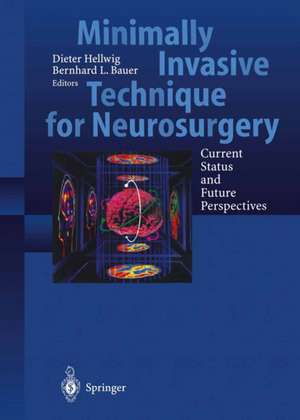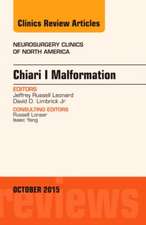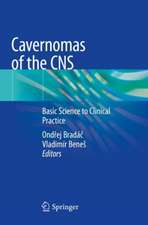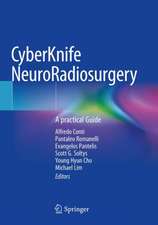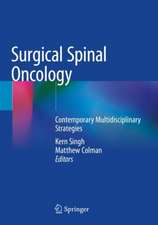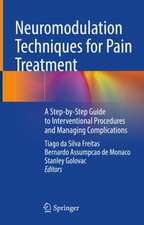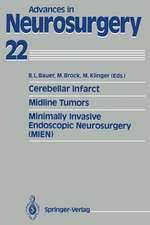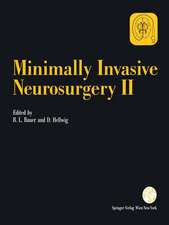Minimally Invasive Techniques for Neurosurgery: Current Status and Future Perspectives
Editat de Dieter Hellwig, Bernhard L. Baueren Limba Engleză Paperback – 17 oct 2012
Preț: 369.05 lei
Preț vechi: 388.48 lei
-5% Nou
Puncte Express: 554
Preț estimativ în valută:
70.61€ • 73.74$ • 58.31£
70.61€ • 73.74$ • 58.31£
Carte tipărită la comandă
Livrare economică 11-17 aprilie
Preluare comenzi: 021 569.72.76
Specificații
ISBN-13: 9783642637018
ISBN-10: 3642637019
Pagini: 328
Ilustrații: XX, 303 p. 185 illus., 42 illus. in color.
Dimensiuni: 193 x 270 x 17 mm
Ediția:Softcover reprint of the original 1st ed. 1998
Editura: Springer Berlin, Heidelberg
Colecția Springer
Locul publicării:Berlin, Heidelberg, Germany
ISBN-10: 3642637019
Pagini: 328
Ilustrații: XX, 303 p. 185 illus., 42 illus. in color.
Dimensiuni: 193 x 270 x 17 mm
Ediția:Softcover reprint of the original 1st ed. 1998
Editura: Springer Berlin, Heidelberg
Colecția Springer
Locul publicării:Berlin, Heidelberg, Germany
Public țintă
ResearchCuprins
Biportal Endomicrosurgery in the Intracranial Subarachnoid Space.- A New Endoscopic System for Neurosurgical Procedures.- Innovative Instruments for Endoscopic Neurosurgery.- Investigation of Approaches to Localize and Control Flexible Neuroendoscopes Automatically.- Endo-Neuro-Sonography: Basics and Current Use.- New Possibilities and Future Developments of Electrosurgery in MIEN.- Three-Dimensional Endoscopy: A Useful Tool for Neuroendoscopy? An Anatomical Study Using MRI and Three-Dimensional Endoscopy.- Spinal Endoscopy in Fixed Human Cadavers: Preliminary Findings with Possible Implications for Implanting Bladder Stimulators in Paraplegic Patients.- Minimally Invasive Techniques in Monitoring of Brain Tissue Oxygenation and Intracranial Pressure in Neurosurgical Intensive Care.- Endoscopic Third Ventriculostomy in Treatment of Obstructive Hydrocephalus Caused by Primary Aqueductal Stenosis.- Third Ventriculostomy in the Treatment of Hydrocephalus: Experience with More than 120 Cases.- The Role of Third Ventriculostomy in Previously Shunted Hydrocephalus.- Ultrasound-Guided Endoscopic Fenestration of the Third Ventricle in Obstructive Hydrocephalus.- Endoscopic Stenting in Aqueductal Stenosis.- Endoscopic Treatment of Posthaemorrhagic Hydrocephalus in Premature Newborns.- Endoscopy of the Ventricular System: Indications, Operative Procedure, and Technical Aspects.- Endoscopic Management of Introcronual Arachnoid Cysts.- The Use of Endoscopes During Surgery in the Suprasellar Region.- Endoscopic Management of Intracranial Arachnoid Cysts.- Endoscopic Pituitary Surgery: Present and Future.- Endoscopic Approach to the Mesencephalon Compared to Standard Microsurgical Procedures.- The Removal of Intracerebral Lateral Hematomas by an Endoscopic Method in Combination withMicrosurgical Techniques and Video System.- Endoscopic Removal of Subdural Hematomas and Hydromas by Microsurgery and Video System.- Linear Accelerator Radiosurgery for Arteriovenous Malformations: The Relationship of Size, Doze, Time, and Planning Factors onto Outcome.- Endoscopic Surgery of Carpal Tunnel Syndrome: Technical Report.- Results of Transillumination-Assisted Carpal Tunnel Release.- Limitations of Endoscopic Release of Carpal Ligament in Carpal Tunnel Syndrome.- The Dilemma of Treating Carpal Tunnel Syndrome: Open Versus Endoscopic Release.- Neuronavigation: A CAS System for Neurosurgery.- Neuronavigation-Assisted Microsurgery of Intracranial Lesions.- Requirements for Referencing of the MKM Neuronavigation System.- Experiences with the Neuronavigation System EasyGuide Neuro.- Early Clinical Experience with the EasyGuide Neuronavigation System and Measurement of Intraoperative Brain Distortion.- Neuronavigation and Neuroendoscopy.- Neuronavigation to the Petrous Bone: A Cadaveric Study.- First Experience with the BainLabVectorVision Neuronavigation System.- Automatically Guided Neuronavigation: First Experience with the SulcusEditor.- Image-Assisted Surgery of Brain Tumors and Other Intracranial Lesions: A Preliminary Report.- Intraoperative Diagnostic and Interventional MRI in Neurosurgery: First Experience with an “Open MR” System.- Functional Magnetic Resonance Imaging in Clinical Neuroscience: Current State and Future Prospects.- Robots for Neurosurgery?.- OR 2015: New Concepts and Technologies in Surgery.- Principles in Neural Transplantation in the Central Nervous System.- Neurosurgical and Restorative Possibilities in the Treatment of Idiopathic Parkinson Syndrome: Neurotransplantation and Neurotrophic Factors.- Preliminary Clinical Experiencewith Neural Transplantation: Two Case Reports.- Molecular Cytogenetics of Malignant Gliomas.- A Role for Hypoxia in Glioma Biology.- Glycosphingolipids: Diagnostic and Therapeutic Relevance in Human Gliomas.
Textul de pe ultima copertă
Today the phrase "Minimally Invasive Neurosurgery" characterizes numerous neurosurgical technologies, techniques and interventions. This book summarizes all facets of this new and rapidly developing field in neurosurgery. Beside neuroendoscopy the main topics are neuronavigation, functional neurosurgery, radiosurgery, neurotransplantation and molecular neurosurgery. Although these topics are not discussed in their full variety, the state of the art and future perspectives of minimally invasive neurosurgery are presented.
Caracteristici
A comprehensive overview of the state of the art and future perspectives in minimally invasive neurosurgery * Describes and evalutes new surgical techniques and new technology * Special attention given to the results of the MINOP project conducted at the research center in Karlsruhe
